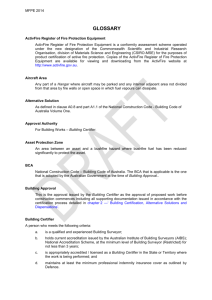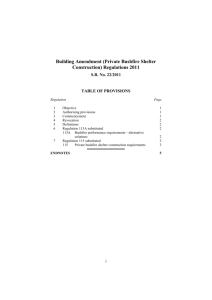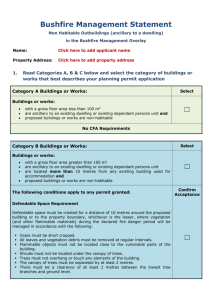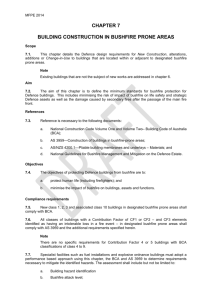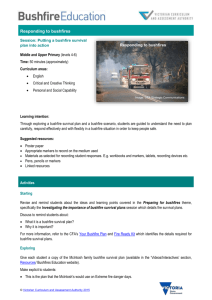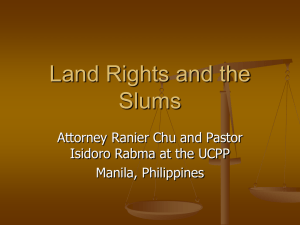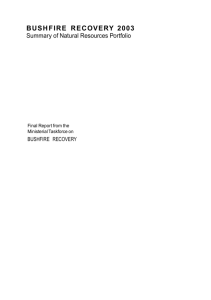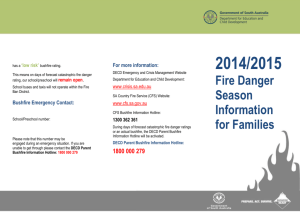NEPEAN BUILDING PERMITS & CONSULTANTS
advertisement
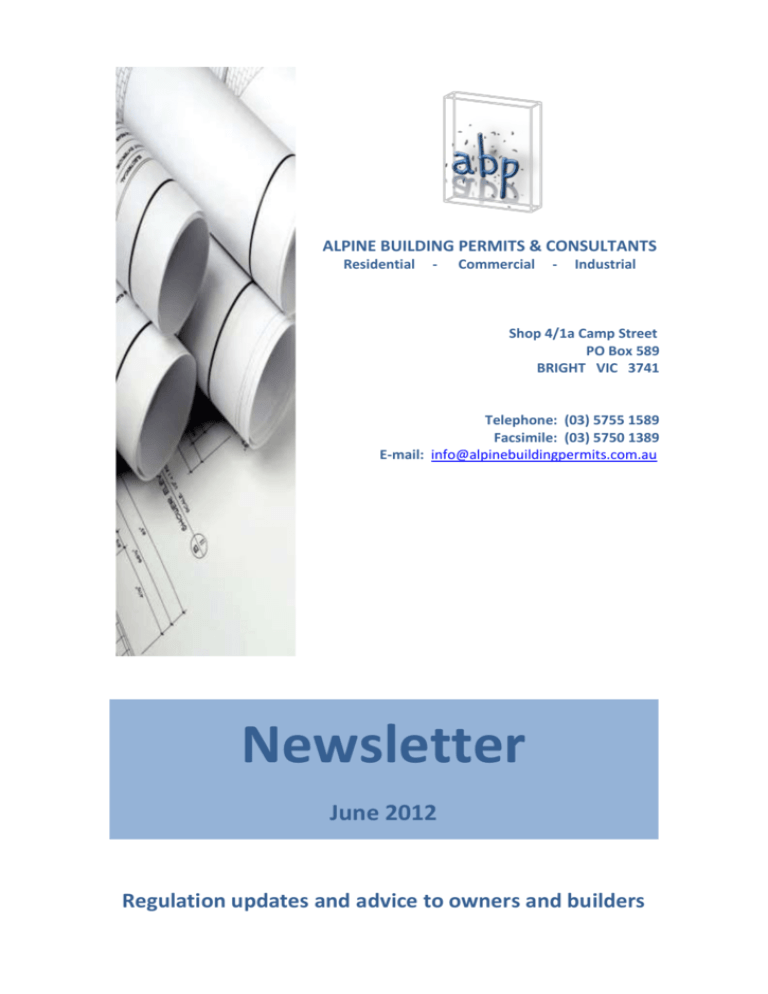
ALPINE BUILDING PERMITS & CONSULTANTS Residential - Commercial - Industrial Shop 4/1a Camp Street PO Box 589 BRIGHT VIC 3741 Telephone: (03) 5755 1589 Facsimile: (03) 5750 1389 E-mail: info@alpinebuildingpermits.com.au Newsletter June 2012 Regulation updates and advice to owners and builders WELCOME Welcome to our first Newsletter. Alpine Building Permits & Consultants has now been in operation for just over six months. During that time we have come to appreciate a noticeable shortfall in the provision of a responsive and efficient building permit service and in the availability of regulatory advice. The privatisation of the building permit system in Victoria (since 1994) is designed to address this situation and provide both owner and builder with an alternative to local government and the ability to select a building permit provider based on quality of service and to a lesser extent, competitiveness of fees. Again in response to an apparent shortfall in this area, we have also expanded our services to include the preparation and submission of planning permit applications including bushfire management statements, pre purchase and owner builder reports and after hours and weekend inspections by appointment. Our services also include the provision of pre-application regulatory advice on preliminary plans. Regulations are constantly changing to meet the expectations of the community and in some instances, the directions of governments. The recent changes to the bushfire regulations (both planning and building) are a direct consequence of the Bushfire Royal Commission. It is difficult for building surveying professionals to keep abreast of the constantly changing landscape let alone owners and builders who don’t have cause to deal with these issues on a daily basis. Therefore the purpose of these Newsletters is to highlight these changes and any other relevant news at regular intervals throughout the year. In addition, we intend to hold information evenings whereby these and other issues can be discussed in more detail. So for anything “building”, don’t hesitate to contact Phil or Glenn at Alpine Building Permits on 5755 1589 or visit our website at www.alpinebuildingpermits.com.au. The website has (under ‘Forms’) all of the application documents and checklists you will need to apply for a building permit. Building Code of Australia The Building Code of Australia (BCA) is part of the National Construction Code series and is the technical standard for both domestic and commercial building. It achieves its legal status by being referenced (nominated) in each state’s building regulations. Each year around May, it is amended to include the latest additions of relevant Australian Standards and to adopt any other changes thought appropriate. The BCA is split into two volumes. Volume 1 deals with Class 2-9 buildings which are essentially commercial, industrial and public type buildings. Volume 2 covers Class 1 and 10 buildings which are basically domestic in nature such as dwellings, sheds, garages, carports and the like. BCA 2012 is now in operation and the major changes to BCA 2011 were: 1. Updates reference to the 2011 edition of AS 2870 – ‘Residential Slabs and Footings – Construction’. The major changes to the standard are: (a) Revision of the overall Standard, such as: New Clause 1.6 on Articulation Requirements Changes to definitions in Clause 1.8 New Clause 2.3 on Estimation of the Characteristic Surface Movement Section 3 on Standard Designs has been updated New Clause 3.4 on Waffle Rafts introduced Section 4 on Design by Engineering Principles has been revised Updated Clause 4.5 on Simplified Method for Raft Designs New Clause 5.5 on Requirements for Aggressive Soils has been introduced. (b) It should be noted that Site Class H has been split into Class H1 and Class H2. (c) There is a new Appendix H on Guide to Design of Footings for Trees. 2. All requirements in relation to masonry construction are now contained in AS 4773 ‘Masonry for small buildings’ Part 1 ‘Design’ and Part 2 ‘Construction’. 3. New provision to reduce trips, slips and falls in residential buildings requiring a handrail to be provided for stairs and ramps (even if the stairway or ramp is enclosed by walls). This of course is not relevant where a handrail is incorporated into the balustrade. New State Bushfire Provisions In September 2011, the State Government introduced new planning and building regulations relating to bushfire protection as a response to the findings of the Bushfire Royal Commission. Bushfire Prone Areas (BPA) mapping has now been completed. If a property is within a BPA, a Bushfire Attack Level (BAL) is required to be determined to establish the minimum level of construction. The criteria for establishing the BAL is outlined in Australian Standard AS 3959 “Construction of Buildings in Bushfire Prone Areas”. All new homes and additions are required to comply with a minimum BAL of 12.5 to resist ember attack. In many instances, a much higher BAL will be necessary. Information pertaining to the establishment of the BAL for a property should be included as part of the building permit application for the proposed works. Outbuildings such as sheds, garages and carports only need to comply with bushfire protection measures if located within 6 m of the existing or proposed dwelling. Wildfire Management Overlays (WMO) under Council planning schemes have also been replaced with Bushfire Management Overlays (BMO). Different planning permit triggers and guidelines apply to the BMO. If the BMO does trigger the need for a planning permit, it is mandatory to provide a Bushfire Management Statement (BMS) with the application. The BMS is a comprehensive report that assesses the proposed works against a variety of standards contained in the planning scheme. It also establishes the relevant BAL which is then used in any building permit application. It is worth noting that the assessment of the relevant BAL for the property through the BMS process is fair more stringent and generally results in a higher BAL than through AS 3959. An additional burden if captured by the BMO is the requirement for a static water supply to be provided on site, usually a minimum of 10,000 litres. This can be difficult to achieve on small allotments and may require the use of underground water tanks to meet the location requirements of the fire authority. For any advice on the new bushfire provisions or to obtain a fee proposal to prepare a bushfire management statement, contact the office on 5755 1589. Part 3.12 of the BCA 2012 Part 3.12 of the BCA deals with the requirements relating to energy efficiency for new dwellings and additions. New dwellings are required to achieve a 6 star house energy rating and an accredited assessor using one of the approved software programs such as FirstRate5, is the normal method of demonstrating compliance with Part 3.12. The program incorporates an assessment of glazing (windows) to be used in the building. In addition, the installation of a solar hot water system OR, minimum 2000lt rainwater tank connected to the sanitary flushing devices is also required for new dwellings. However, the current software programs do not include provision to verifying electrical lighting compliance required under Part 3.12.5.5. In simple terms, a dwelling has a maximum lighting allowance of 5 watts per square meter of floor area. So, a simple table nominating the total wattage of lights in each room in comparison to floor area is required to be submitted as a separate attachment to the 6 star report. For dwelling additions, the process is a little more complicated. Although house energy rating software can be used, there is a requirement that the assessor generate two reports. One on the existing dwelling and another with the proposed additions included. The relevant building surveyor then has an opportunity under the Building Regulations to exempt the existing building from achieving a 6 star rating. Alternatively, the drawings with an application for building permit or as a separate report, can individually address the specific requirements of Part 3.12 such as building fabric (insulation), building sealing and glazing. Given the all of the sub alpine area is in Climate Zone 7, this requires high insulations levels for floor, wall and ceiling/roof and the nomination of draught excluders on external doors. For glazing verification, the Australian Building Codes Board (ABCB) has produced a simple Excel based spread sheet that allows the input of all windows (both proposed and existing) and automatically calculates if satisfactory. The calculator can be downloaded for free at www.abcb.gov.au. An electrical lighting schedule outlined above, is still required for additions. Generally, where the proposed additions are less than a 50% increase in floor area over the existing dwelling, there is no obligation to undertake any upgrade works on the existing building. If the additions are over a 50% increase, fundamentally there is a requirement to upgrade however, the relevant building surveyor has discretionary powers to allow partial or full compliance (depending on what is reasonable) in these circumstances. POLYSTYRENE WALL CLADDING Foam board wall cladding has slowly been introduced into the new building construction over a number of years. There are numerous products now on the market. Unfortunately, many have not been tested and accredited for use as an external cladding material under the BCA. Most people would not be aware that as an external cladding, it is not an ‘as of right’ material that can be used without supporting documentation unlike brickwork, blockwork, timber, steel sheet, etc. Therefore, if you are contemplating using foam board, ensure that it has a certificate of accreditation and that your supplier provides a copy of the certificate along with installation instructions. The relevant building surveyor can only approve the use of a foam board that has been accredited. ACCESS AND MOBILITY The BCA has been significantly expanded to include access requirements on buildings previously excluded such as 2 storey office buildings, small accommodation buildings such as B&B’s. Fortunately at this stage, single dwellings are not captured by the legislation. All designers and builders that will have cause to deal with buildings other than domestic dwellings should obtain a copy of Australian Standard AS 1428.1 – 2009. The current standard changed considerably from the 2001 edition particularly in relation to the following: Larger sanitary compartments. Larger circulation spaces including the need for passing and turning spaces. Larger doorways. Increased distances to the latched side of doorways. D type lever door handle or similar required. REMINDER Lodge your building permit applications from the comfort of your own home/office. Simply scan and email documents to info@alpinebuildingpermits.com.au or fax to 035750 1389. We undertake to assess all applications within 3 days of lodgement and provide advice as to any further information or documents required for the issue of a building permit.



